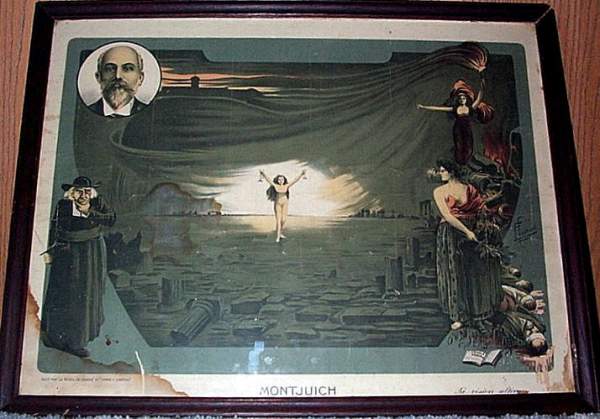
|
.
|
http://www.geocities.com/Athens/Acropolis/5422/harper.html from Anarchy: A Graphic Guide by Clifford Harper BARCELONA, July 11th, 1909 Large army units eventually arrived and, in spite of furious resistance, by July 31st the last worker’s barricades were overcome by artillery, leaving 600 workers dead. Martial law was imposed throughout Spain, and 500 were tried for insurrection. FRANCISCO FERRER AND THE FREE SCHOOLSAmong those facing the military court was a teacher, Francisco Ferrer. Although he had not been near Barcelona at any time during the rising, he was charged with being head of the insurrection. Ferrer had discovered anarchism in the clubs and bars of Paris, where he had been exiled after the 1885 republican uprising. It was there that he met the anarchist Paul Robin, head of the Cempuis school and the inspiration for the League for Libertarian Education. Ferrer, then 24 years old, dreamed of creating a similar school in Spain. Having been left a million francs by a benefactor, Ferrer opened his Modern School in Barcelona on September 8th, 1901. Until that time, Spanish schooling was entirely controlled by the Church. Only one town in three had a school, and all schools were supervised by priests, with teachers sworn to uphold Catholic dogma. Ferrer intended his Modern School to challenge all that:
Ferrer was opposed to both Church and State schooling:
The Modern School had no rewards or punishments, exams or marks—the everyday tortures of conventional schooling. And because practical knowledge is more useful than theory, lessons were often held in factories, museums or the countryside. The school was also used by the parents, and Ferrer planned a Popular University.
The Modern School was also a propaganda centre, a training ground for revolutionary activity:
Soon the school had 125 pupils and the example spread. By 1905 there were 50 similar schools in Spain. On Good Friday of that year, Ferrer led 1700 children in a demonstration for free education. Within weeks the government acted and forcibly closed all the schools. Earlier that year anarchists had twice thrown bombs at Spain's King Alfonso. One of them, Mateo Morral, worked at the Modern School’s printing press and was a close friend of Ferrer. For this Ferrer was jailed for a year. On his release he travelled throughout Europe spreading the Free School message. After returning to Spain, Ferrer was again arrested following the Tragic Week of 1909 and was executed by firing squad. But his death did nothing to diminish the force of his ideas. Modern Schools were founded in Britain, France, Belgium, Holland, Italy, Germany, Switzerland, Poland, Czechoslovakia, Yugoslavia, Argentina, Brazil, Mexico, China, Japan and, on the greatest scale, in the USA.  |